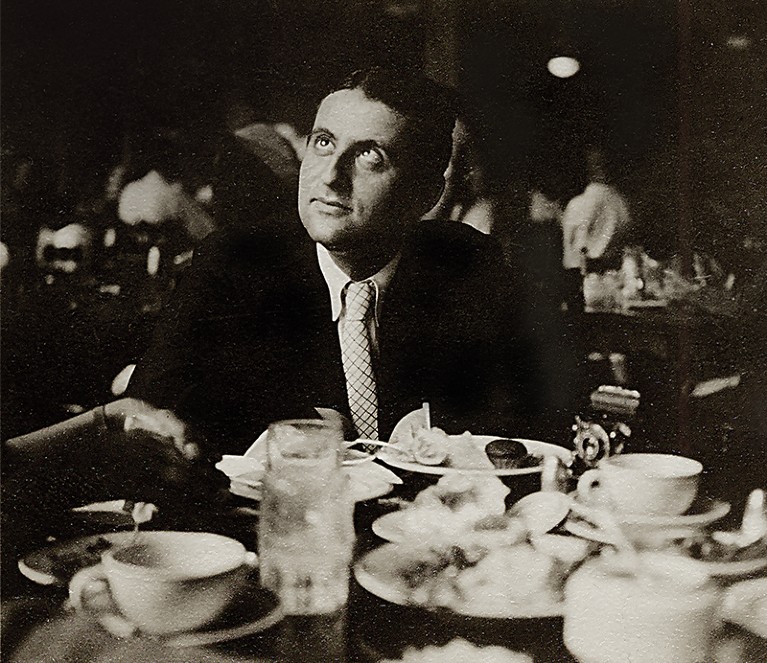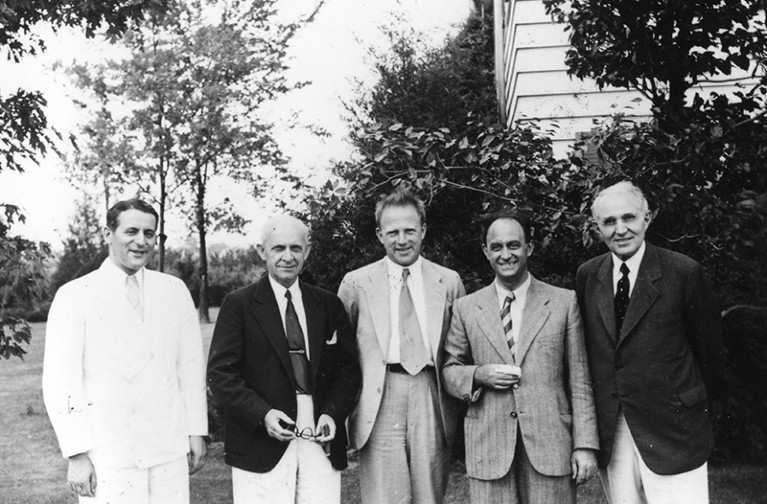
Samuel Goudsmit at a dinner at the University of Michigan in Ann Arbor around the 1930s.Credit: AIP Emilio Segrè Visual Archives
Sam Goudsmit and the Hunt for Hitler’s Atom Bomb Martijn Van Calmthout Prometheus (2018)
In 1945, four months after the end of the Second World War in Europe, a 40-something man drove a US Army Jeep through the ravaged streets of The Hague in the Netherlands, where he had grown up. When Samuel Goudsmit stepped into his parents’ house, he found it partly dismantled — probably scavenged for wood. He knew he would not find his parents here; two years before, he had received a farewell letter from his mother Marianne, postmarked Westerbork. This was the transit camp where she and many other Dutch people of Jewish ancestry, including Anne Frank, were held on the way to Nazi extermination camps such as Auschwitz.
This scene is a fitting start to the gripping Sam Goudsmit and the Hunt for Hitler’s Atom Bomb (first published in Dutch in 2016, now translated into English by Michiel Horn). Author Martijn van Calmthout (former science editor of Amsterdam-based newspaper De Volkskrant) argues that the wartime years are the key to understanding Goudsmit’s extraordinary life. His achievements spanned the co-discovery of quantum spin, the successful search for Adolf Hitler’s atomic scientists and the founding of pre-eminent physics journal Physical Review Letters — as well as at least 48 nominations for a Nobel prize. Goudsmit overcame significant hardships, along with the painful knowledge that he wasn’t in the same league as other quantum pioneers.
Goudsmit stumbled to fame in 1925. For more than a decade, Niels Bohr and others had been trying to develop a quantum theory of the atom, mostly by studying atomic spectra. These consist of the energies (specific to each element) of the quanta of light, or photons, that an atom’s electrons can absorb or emit. Physicists had been struggling to make sense of anomalies that appeared in spectra when atoms were immersed in a magnetic field: some spectral levels mysteriously split into two or more. Goudsmit and his friend George Uhlenbeck, both graduate students at Leiden University in the Netherlands, had an idea.
They proposed that the splitting could be explained if the electron had an intrinsic ‘spin’ that could assume one of two directions: clockwise or anticlockwise. Other physicists had discarded this idea, seeing it as marred by conceptual difficulties. For instance, it seemed to imply that electrons should rotate faster than the speed of light. Goudsmit and Uhlenbeck were blissfully unaware of all that. (And more: when Uhlenbeck suggested spin as an extra degree of freedom for the electron, Goudsmit asked, “What is a degree of freedom?”) Their paper was published that year (G. E. Uhlenbeck and S. Goudsmit Naturwissenschaften 13, 953–954; 1925).
Soon, researchers including Paul Dirac explained away the conceptual difficulties. Quantum spin was born. It is one of the basic properties of all subatomic particles, and a crucial step to understanding the periodic table: without it, atomic structure would be completely different. Yet Goudsmit and Uhlenbeck never received a Nobel prize for their discovery, perhaps because the idea had already been discussed by others, including physicist Ralph Kronig.
After graduation, the two researchers emigrated to the United States, setting the stage for Goudsmit’s participation in the US war effort. German scientists discovered nuclear fission in 1938. During the war, Allied forces feared that Hitler might be close to having an atomic bomb. So, in 1944, as D-Day approached, Leslie Groves — the general in charge of the Manhattan Project, the United States’ own effort to build the bomb — organized an intelligence mission to follow the Allied invasion. It would scour Germany for clues to the country’s nuclear efforts, and apprehend its leading nuclear physicists.
Goudsmit was picked as scientific leader. As van Calmthout argues, Goudsmit was perhaps uniquely qualified for the job. Physics was a small world then, and he knew most of the potential suspects personally, notably his friend Werner Heisenberg, founder of quantum mechanics and undisputed leader of Germany’s physics community. Goudsmit also had an investigator’s nose: he grew up reading detective stories, and had even considered a career in forensic science.
If van Calmthout’s account of the mission reads like a thriller, that’s because it was. It culminates with the discovery of Heisenberg’s lab in Haigerloch, Germany, where, in hiding, he had tried and failed to get a primitive nuclear reactor started in a former beer cellar. When US soldiers walked into Heisenberg’s office, they found a photo of him taken in Michigan in 1939. Goudsmit was in it, too: he ran the summer school that Heisenberg was visiting at the time.

Samuel Goudsmit (far left) at the University of Michigan in Ann Arbor in 1939, with (left to right) university vice-president Clarence Yoakum, physicists Werner Heisenberg and Enrico Fermi, and mineralogist Edward Kraus.Credit: AIP Emilio Segrè Visual Archives
Goudsmit told this story in his spellbinding 1947 memoir, Alsos (the mission’s code name). But van Calmthout’s narrative is hugely enriched by details from other sources. These include letters from Goudsmit to his first wife, Jaantje, and now-declassified documents. Key among these are the transcripts of recordings collected by British intelligence while eavesdropping on Heisenberg and fellow physicists during their internment in a Cambridgeshire country house, Farm Hall (see A. Finkbeiner Nature 503, 466–467; 2013).
Goudsmit realized as early as November 1944 that the Nazis’ nuclear ‘programme’ never amounted to much. The question of why not is still controversial, and van Calmthout does a good job of describing its subtleties. One thing is clear. The ‘official’ version that Heisenberg presented postwar — that they could have built a bomb, but decided not to — became untenable after the Farm Hall transcripts were declassified in the 1990s. Those show that some of the interned scientists even mocked Heisenberg for being a “second-rater”.
Although van Calmthout has a background in physics, Sam Goudsmit is not a scientific biography. It devotes little space to the intellectual development of ideas during what was the most momentous period in physics history so far. This makes the book accessible. But it has few references and no notes. Van Calmthout taps his source material liberally, but is coy on their details.
Goudsmit’s later years might seem anticlimactic. He died in 1978; before that, he lived comfortably as a high-level official in a US national lab and as editor-in-chief of Physical Review and its spin-off, Physical Reviews Letters, which he founded in 1958. All along, he complained about how Big Physics had changed the field by necessitating expensive machinery. But his later achievements perhaps hold a lesson for an era in which despotism is once again on the rise globally. They show how Goudsmit’s generation of scientists managed, despite the depredations and cruelties of Nazism, to persist long after the Reich had fallen.

 Atomic bombs through wars hot and cold
Atomic bombs through wars hot and cold
 Winston and the warheads
Winston and the warheads
 Overhearing Heisenberg
Overhearing Heisenberg
 Physics: Atomic secrets
Physics: Atomic secrets







